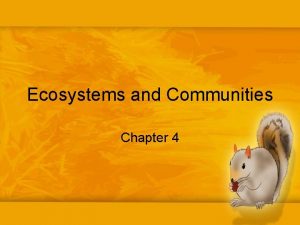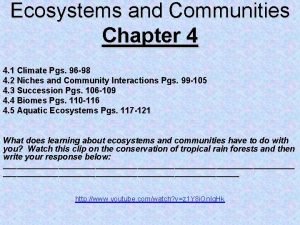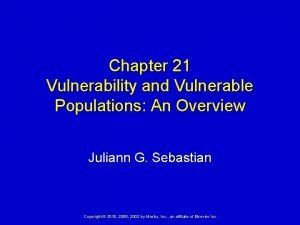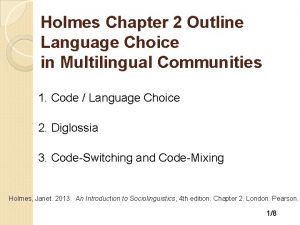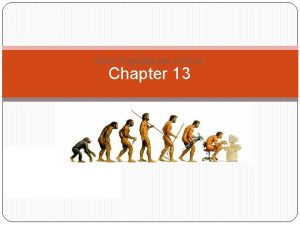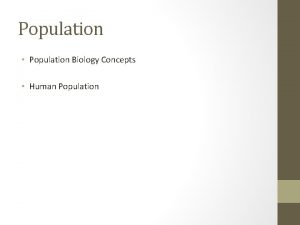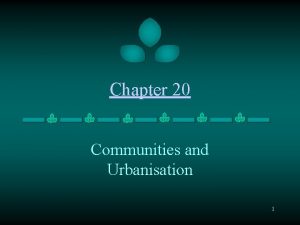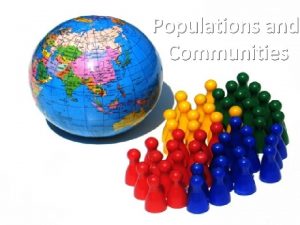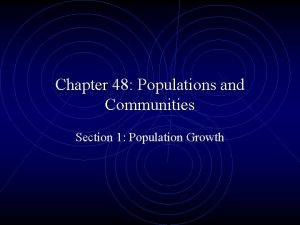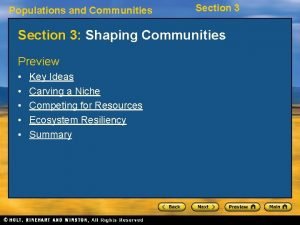Chapter 5 Populations and Communities Populations A population











- Slides: 11

Chapter 5 Populations and Communities

Populations • A population is made up of a group of organisms that live in the same geographical area and interbreed. • Understanding population growth is important because populations of different species interact and affect one another, including human populations.

Population Growth • Immigration- the movement of individuals into a population. • Emigration- the movement of individuals out of a population. • Exponential growth occurs when numbers increase by a certain factor in each successive time period.

• Carrying capacity is the largest population that an environment can support at an given time. • Density dependent factors-variables affected by the number of organisms present in a given area. • Density independent factors-variables that affect a population regardless of the population density. • Logistic growth-population growth that starts with a minimum number of individuals and reaches a maximum depending on the carrying capacity of the habitat.

Factors that affect the population. • Water, food, predators, and human activity are a few of many factors that affect the size of a population. • Abiotic factors-nonliving factors that affect population size • Biotic factors-factor that is related to the activities of living things.

Human population • Better sanitation and hygiene, disease control, and agriculture technology are a few ways that science and technology have decrease that death rate of the human population.

Predator-prey interactions • Predation-an interaction between two organisms in which one organism, the predator, kills and feeds on the other organism, the prey. • Species that involve predator-prey or parasite-host relationships often develop adaptations in response to one another. • Coevolution-the evolution of two or more species that is due to mutual influence. • Parasitism-a relationship between two species in which one species, the parasite, benefits from the other species, the host, which is harmed.

Other interactions • Symbiosis-a relationship in which two different organisms live in close association with each other. • Mutualism and communalism are two kinds of symbiotic relationships in which at least one species benefits. • Mutualism-a relationship between two species in which both species benefit. • Commensalism-a relationship between two organisms in which one organism benefits and the other is unaffected.

Carving a niche • Niche-position occupied by a species, both in terms of its physical use of its habitat and its function in an ecological community. • Habitat-place where an organism lives. • A niche includes that role that the organism plays in the community. This role affects other organisms in the community.

Competing for resources • Fundamental niche-the largest ecological niche where an organism or species can live without competition. • Competition for resources between species shapes of species’ fundamental niche. • Realized niche-the range of resources that a species uses, the conditions that the species can tolerate, and the functional roles that the species plays as a result of competition in the species’ fundamental niche. • Competitive exclusion-the exclusion of one species be another due to competition.

Ecosystem resiliency • Interactions between organisms and the number of species in an ecosystem add to the resiliency of an ecosystem. • Preparation can reduce the affects of competition among species. • Keystone species-a species that is critical to the functioning of the ecosystem in which it lives because it affects the survival and abundance of many other species in its community.
 Crustose lichen stage
Crustose lichen stage Chapter 4 section 1 population dynamics
Chapter 4 section 1 population dynamics Chapter 4 population ecology answer key
Chapter 4 population ecology answer key Population ecology section 1 population dynamics answer key
Population ecology section 1 population dynamics answer key Population ecology section 1 population dynamics
Population ecology section 1 population dynamics Ecosystems and communities chapter 4 answer key
Ecosystems and communities chapter 4 answer key Parasitism examples
Parasitism examples Chapter 21 vulnerability and vulnerable populations
Chapter 21 vulnerability and vulnerable populations Language
Language Chapter 16 evolution of populations vocabulary review
Chapter 16 evolution of populations vocabulary review Chapter 13 how populations evolve test
Chapter 13 how populations evolve test Chapter 17 evolution of populations answer key
Chapter 17 evolution of populations answer key





